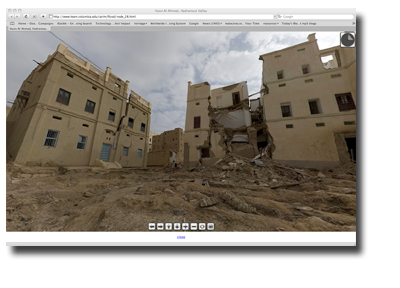 |
| QTVR of Husn Al Ahmed (link below). Will Raynolds. |
A Brief Account of the Flooding in the Hadramaut
Will Raynolds
Two representatives of the Tarim Documentation Project traveled to Yemen during December-January to assess the damage of the flood that occurred in Wadi Hadramaut in late October 2008. The largest flood in 230 years, it destroyed some 3,500 homes, almost all of them made of mud-brick using the same techniques exhibited in these pages. Fortunately, flood damage was relatively light within the city limits of Tarim, though many of the Qasur documented by this project (including Hamtut, al Riyad, Abd al Rahman bin Sheikh al Kaf, al Fijr, and al Isha’a) did endure some damage. Existing cracks extended and multiplied; some ceilings collapsed.
Flood damage was more severe elsewhere in the Hadramaut Valley, with significant damage in the municipalities of Thiby and al-Jahil (both on the outskirts of Tarim), and stretching further up the wadi to al-Quz, a- Ba’dir, al-Mishdah, and a- Sah as well as westward to Shibam al-Sahil, Husn Al Ahmed, Husn Al Zua’, Saha' Ali a- Haj, and aMuraghda. Though flood warnings were issued early enough to avert most human casualties, the homes swept away in the torrent represent a catastrophic loss for the extended families that once lived in them.
While more than 100 million USD have been pledged in relief efforts aiding flood victims, those who lost their homes are still living in tents and there is woefully little sign of rebuilding. The Yemeni government and international organizations involved with the reconstruction will face difficult questions balancing the expediency of quickly rebuilding with cinder block versus a more sustainable and long-term investment in local mud brick technology and craftsmenship.
View QTVR nodes of the damage:
Additional Links:

